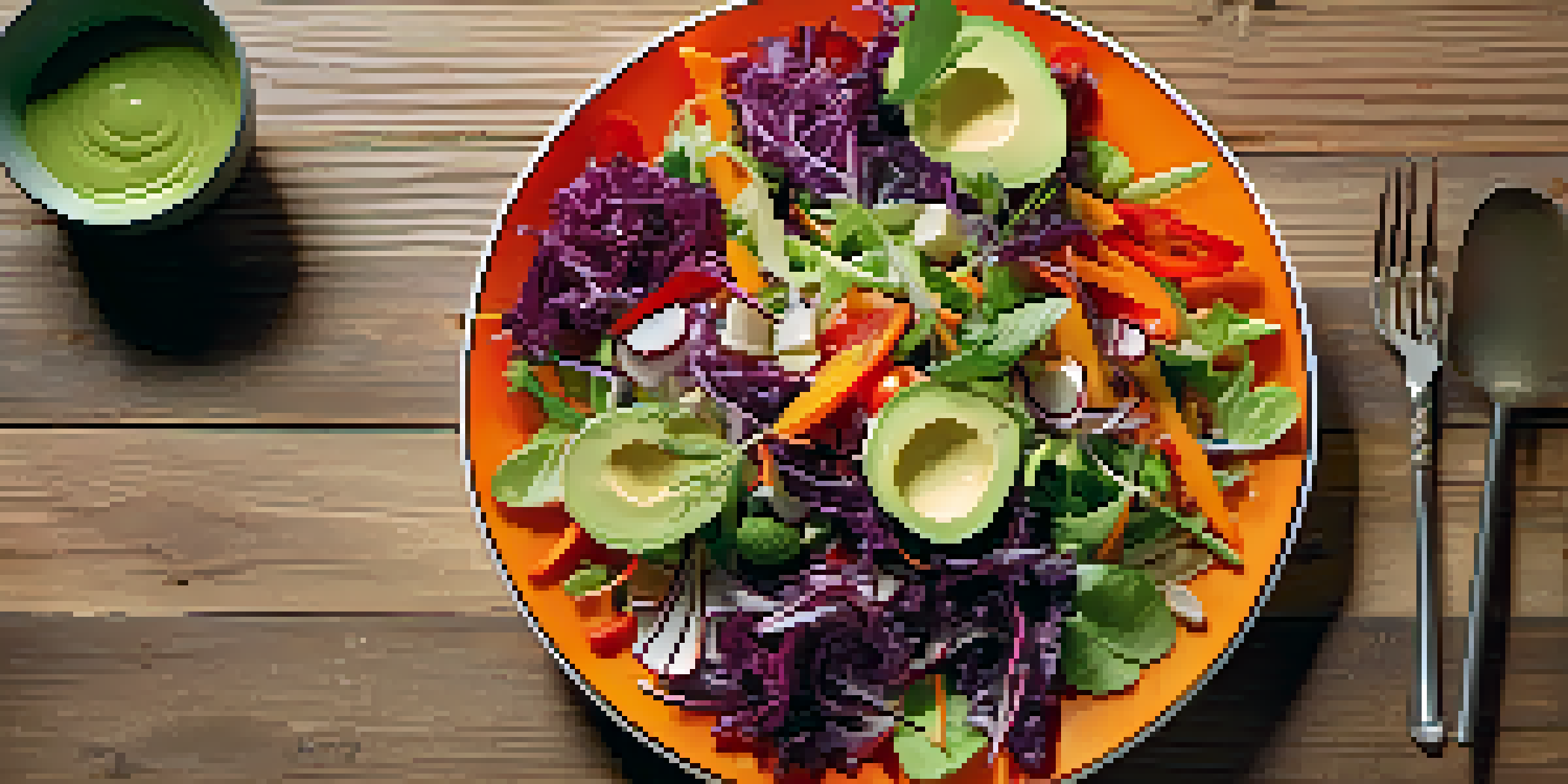Food Pairing for Health: A Culinary Medicine Approach

Understanding Culinary Medicine and Its Importance
Culinary medicine is an exciting blend of cooking and healthcare, focusing on how food impacts our well-being. This approach emphasizes not just the nutritional value of ingredients but also how their combinations can enhance health. By understanding the science of food pairing, we can create meals that support our bodies in specific ways.
Let food be thy medicine and medicine be thy food.
For instance, pairing leafy greens with healthy fats, like avocado or olive oil, allows our bodies to absorb more nutrients. This small adjustment can make a significant difference in how effectively we receive vitamins and minerals. In a world where health trends come and go, culinary medicine offers a practical, evidence-based approach to eating well.
As we explore food pairing further, we’ll see how simple adjustments in our meals can lead to better health outcomes. This knowledge empowers us to make informed choices in the kitchen while enjoying the pleasures of cooking and eating.
The Science Behind Food Pairing and Health Benefits
The science of food pairing is rooted in understanding how different foods interact within our bodies. Certain combinations can enhance nutrient absorption, improve digestion, and even promote better mental health. For example, pairing fiber-rich foods with protein can stabilize blood sugar levels, which is essential for maintaining energy throughout the day.

Additionally, certain foods work synergistically to boost our immune system. Think of garlic and ginger—both are known for their health benefits, but together, they create a powerful immune-boosting effect. This synergy illustrates how food pairing can transform ordinary meals into health-enhancing powerhouses.
Culinary Medicine Enhances Health
Culinary medicine focuses on food pairing to improve nutrient absorption and support overall well-being.
By being mindful of these combinations, we can navigate our diets more effectively. This knowledge not only promotes better health but also encourages creativity in the kitchen, making meal preparation an enjoyable and rewarding experience.
Practical Tips for Pairing Foods for Better Health
When it comes to food pairing, simplicity is key. Start by incorporating a variety of colors on your plate, which often signifies a range of nutrients. For example, a colorful salad with carrots, bell peppers, and dark leafy greens can provide a broad spectrum of vitamins and minerals that work together for your health.
The doctor of the future will no longer treat the human frame with drugs, but rather will cure and prevent disease with nutrition.
Another tip is to think about textures and flavors. Combining crunchy vegetables with creamy dressings not only creates a satisfying meal but also enhances the overall eating experience. This approach can make healthy eating feel less like a chore and more like a culinary adventure.
Lastly, don't shy away from experimenting! Try pairing unexpected ingredients to discover new favorites. You might be surprised by how well certain foods complement each other, leading to delicious and healthful meals.
Exploring Flavor Pairings That Boost Health
Flavor is an essential component of food pairing, and certain combinations can lead to enhanced health benefits. For instance, pairing tomatoes with olive oil not only creates a delicious dish but also helps the body absorb lycopene, a powerful antioxidant found in tomatoes. This kind of pairing showcases how taste and health can go hand in hand.
Herbs and spices also play a crucial role in flavor pairing. For example, adding turmeric to your meals can offer anti-inflammatory benefits, especially when combined with black pepper, which enhances the absorption of curcumin, the active compound in turmeric. These flavor-rich pairings not only elevate your dishes but also contribute to your overall wellness.
Seasonal Ingredients Boost Flavor
Using seasonal ingredients not only provides fresh flavors but also maximizes nutritional benefits.
Ultimately, the more you explore flavor pairings, the more you’ll discover how they can transform your cooking. This exploration makes the journey towards better health through food both exciting and delicious.
Seasonal Ingredients: Nature’s Best Food Pairings
Eating seasonally is a fantastic way to enhance your meals through natural food pairings. Seasonal ingredients are often fresher, more flavorful, and packed with nutrients. For instance, in the summer, pairing ripe tomatoes with basil not only celebrates local produce but also creates a dish that bursts with flavor and health benefits.
Moreover, seasonal foods are typically more affordable, allowing you to experiment with various combinations without breaking the bank. Think about autumn vegetables like squash paired with warming spices such as cinnamon or nutmeg. These combinations not only taste great but also offer comfort and nourishment during the cooler months.
By choosing seasonal ingredients, you not only support local farmers but also embrace the natural rhythm of food availability. This practice encourages a deeper connection to what we eat, fostering a more mindful approach to our meals.
Culinary Medicine and Its Role in Preventive Health
Culinary medicine isn't just about enjoying delicious meals; it plays a critical role in preventive health. By choosing nutrient-dense foods and understanding how they work together, we can reduce the risk of chronic diseases such as diabetes, heart disease, and obesity. For example, a diet rich in whole grains, fruits, and vegetables has been linked to lower inflammation and better overall health.
Moreover, culinary medicine empowers individuals to take control of their health through food choices. Rather than solely relying on medication, people can use diet as a tool for prevention and wellness. This proactive approach can lead to long-term health benefits and a higher quality of life.
Food Choices Prevent Chronic Diseases
By making informed food choices, culinary medicine empowers individuals to reduce the risk of chronic illnesses.
Incorporating culinary medicine principles into daily life encourages a holistic view of health. By combining good food, mindful eating, and awareness of our bodies, we can create a sustainable path to better health.
Conclusion: Embracing Food Pairing for a Healthier Future
As we wrap up our exploration of food pairing through the lens of culinary medicine, it’s clear that small changes can lead to big health benefits. By understanding how different foods work together, we can create meals that nourish our bodies and delight our taste buds. It’s not just about eating; it’s about enjoying the journey of exploring flavors and health.
Embracing food pairing means being open to experimentation in the kitchen. It involves a willingness to try new ingredients and combinations that not only taste good but also provide health benefits. This mindset can transform our relationship with food, making it a source of joy and vitality rather than just sustenance.

Ultimately, by integrating culinary medicine into our daily lives, we can pave the way for a healthier future. Let’s celebrate the power of food and its ability to enhance our well-being, one delicious meal at a time.